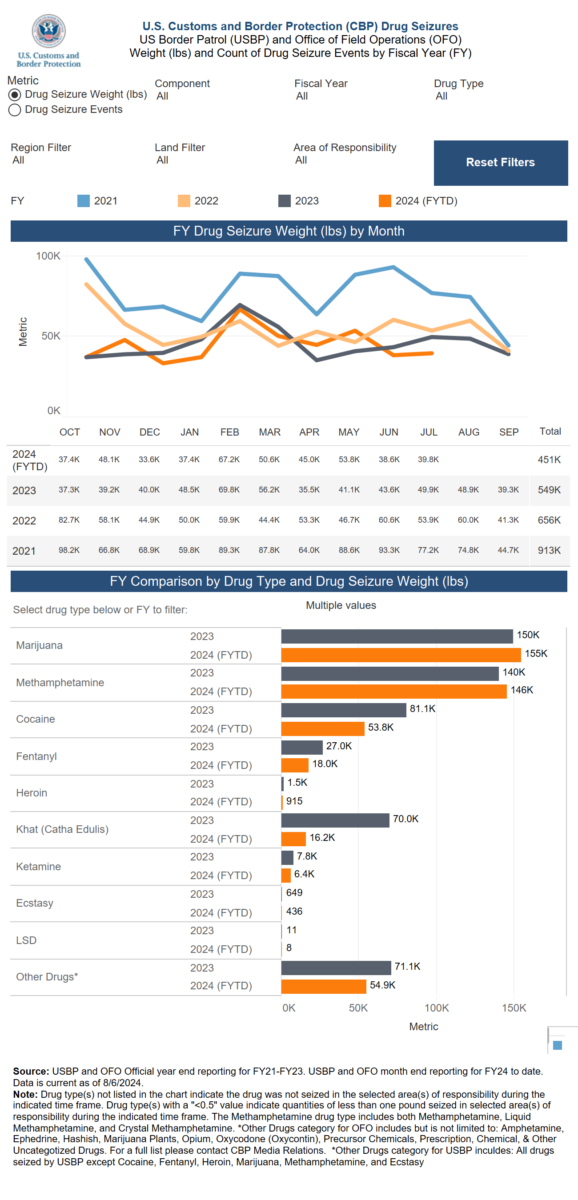As nearshoring increases the volume of products carried across the U.S. border, seizures of illegal narcotics from freight are also on the rise. Roughly 1,100 U.S. Customs and Border Protection officers at the Laredo Port of Entry process 8,000 to 10,000 trucks daily to combat the influx of contraband.

The Laredo Port of Entry falls within the Laredo Field Office, which is headquartered in Laredo, Texas, on the U.S.-Mexico border and oversees eight ports of entry from Brownsville to Del Rio. Albert Flores is the CBP port director for the Laredo Port of Entry and has over 28 years of experience in federal service.
Flores said CBP officers seize a variety of narcotics from cargo at the border. In the past year, however, Flores said methamphetamine is the narcotic that officers have been seeing the most consistently in cargo.
“Narcotic seizures are going to ebb and flow over a period of time,” Flores told FreightWaves in a phone interview. “But right now if you look at our field office … year to date, we have seized roughly about 29,400 pounds of methamphetamines. That’s quite a bit, and if you look at the entire fiscal year 2023 data, we seized about 19,265 pounds. So right now we’re already at a 40% increase and still have about a month and a half to go to close out the fiscal year.”
During the writing of this article, CBP announced on Tuesday that officers at the Laredo Port of Entry had seized over 50 pounds of meth from a vehicle crossing the border. It was valued at over $773,000.

It’s not just Laredo. According to CBP data, over 145,000 pounds of meth has been seized so far from all U.S. ports of entry for the 2024 fiscal year that ends Sept. 30. This is an increase from over 140,000 pounds of meth seized last year during that same period. CBP has also seen an increase in marijuana crossing the border, with 155,000 pounds seized so far in 2024 compared to 150,000 pounds last year.
On the other hand, cocaine and khat – a flowering shrub from Africa used as a stimulant – have seen big decreases in seizures at all ports of entry. Cocaine has dropped from over 81,000 pounds in 2023 to just under 54,000 pounds so far in 2024. Khat has dived from over 70,000 pounds seized in 2023 to just under 55,000 pounds so far this year.
Over the last three years, total drugs seized by CBP have significantly decreased. In 2021, for example, CBP reports 913,000 pounds of drugs were seized. So far this fiscal year, 451,000 pounds – roughly half of 2021’s amount – have been seized.
Flores said anytime there is a drug seizure, CBP calls Homeland Security Investigations to speak with the driver of the vehicle and determine if there was any culpability regarding smuggling of the contraband or if it was hidden in the vehicle without the driver’s knowledge.
“Roughly about 85% of the cargo that we process here at the Port of Laredo originates in the interior of Mexico,” Flores said. “Oftentimes, a lot of [the investigation on culpability] is dependent on how and where drugs are concealed. In this case, the case agent will make the determination if there is involvement or not.”
Flores and his colleagues at CBP have seen cartels attempt to smuggle contraband across the border in a variety of ways, from meth inside lettuce shipments to cocaine disguised as watermelons.
“The drug cartels are going to evolve in the way that CBP does in the technology that we have to be able to scan these commodities,” Flores said. “You’re looking at shipments of legitimate furniture and produce. We sometimes see drugs concealed within the walls of [semitruck] trailers. Sometimes we even just see duffle bags that have narcotics either thrown inside the trailer or in a place right next to where the driver is operating the [vehicle].”
Ordinary products are checked for cross contamination during drug seizures at the border. Flores said these commodities are destroyed if they are contaminated. If there’s no harm to the products, CBP works with the parties involved to have the product transhipped to its destination.
Inspecting cargo at the border
Flores said CBP uses a layered enforcement approach to its inspection process. That means that for every cargo truck arriving at the port, CBP needs to have cargo information provided at least an hour in advance.
“That will allow our team of officers to review that data and then make a determination whether we would want to see that cargo in our secondary inspection area or allow it to proceed to the gate,” Flores said.
Red flags that officers look for during the inspection process include nervousness from the driver, anything out of the ordinary, and indications of tampering with the tractor trailer or the locks and seals on product containers.
“It varies from truck to truck, but generally there are multiple areas within the import process that the truck is being inspected,” Flores said.
He said improvements in transactional technology have been valuable, allowing officers to compile all cargo information in one screening.
“I think CBP as a whole has made tremendous strides as far as being able to provide officers with all the information of a particular shipment that they have in front of them,” Flores said.
Screening tools available to law enforcement include drug-sniffing K-9 dogs, cameras, X-rays and other drive-through systems called multi-energy portals (MEPs). Flores said his port has two new MEPs that cargo trucks can pass through. The devices perform a low-energy scan for the tractor followed by a higher-energy X-ray scan for the trailer.
“The wonderful thing about this new technology is that the truck drives through, the image is then routed to a control center where officers are doing analysis on the images, and then by the time the truck arrives to the primary booth there’s already been a determination whether that truck is going to go to secondary or if it’s going to proceed into the commerce of the U.S.,” Flores said.
Nearshoring challenges
Flores said CBP’s biggest challenges lately have come from the large volume of cargo crossing the border at all ports of entry.
As U.S. companies continue nearshoring across the border to manufacture goods in Mexico, Flores said his port has been tracking an increase of cargo crossing the border by 3% to 5% every year since 2010 – excluding 2020 during the pandemic.
“With this nearshoring, not only will Laredo have to deal with the increasing volumes of cargo, but I think the entire Southern border is going to see that,” Flores said. “By implementing measures and technology to meet the threat – which is going to include the installation of the multi-energy portals in the pre-primary area – utilizing these systems to be able to scan and adjudicate images before the truck arrives for primary inspections are going to be huge for our multilayered approach that is employed across the Southern border.”
CTPAT, FAST and the supply chain
To enhance safety and make the screening process smoother, Flores highly recommends drivers and companies partner with CBP through the Customs and Trade Partnership Against Terrorism (CTPAT) program.
Established during the aftermath of 9/11, CTPAT is an agreement between participating companies and CBP to protect the supply chain, identify security gaps and implement specific security measures and best practices. CTPAT partners receive a variety of benefits to better identify their own security vulnerabilities and take corrective action to mitigate risks. Among the benefits are:
- Fewer CBP examinations.
- Front-of-the-line inspections.
- Shorter wait times at the border.
- Access to the Free and Secure Trade (FAST) Lanes at land borders.
“Recently, the Port of Laredo, through a private-public partnership with the city of Laredo, did open up four new lanes dedicated to the FAST cargo that we process here at the Port Laredo,” Flores said. “It’s pretty significant when you look at the cargo that we do here. Thirty percent of the cargo that we do daily is offered to us through the FAST program, which is quite impressive.”
Earlier this summer, the office of U.S. Rep. Henry Cuellar, D-Texas, announced plans to establish a new CTPAT office at Port Laredo. Flores said the office is being set up over the next month and is expected to begin operating as soon as the start of the new fiscal year in October.
“The Laredo Port of Entry has long been the frontline for trade with Mexico and 68% of all importations by value are CTPAT participants,” Flores said. “So you have existing CTPAT members that use Laredo. And the likelihood of getting more people enrolled with the program is obviously going to increase with having people on-site and available to meet with carriers and exporters that want to enroll in this program.”
